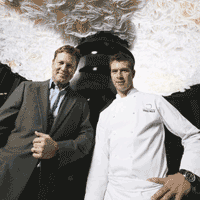Joey Restaurant Group is thriving, one unique resto at a time
Company of The Year, Regional, Western Canada
The warm, late evening sun is just beginning to dip behind nearby buildingsas patrons mingle and sip glasses of Chardonnay and muddled mojitos to help fight the summer heat in Canada’s largest city. It’s the grand opening of the expansive patio at Joey Don Mills, the latest high-water mark in Joey Restaurant Group’s march across the country.
At the time, guests surveyed the new digs, with its cool, hip design and wondered when they’d see identical clones across the city. Little did the uninitiated Ontarians know, things are a little different at Joey, which over the last few years, has achieved remarkable success and growth, by refusing to adopt many of the standardized rules of the chain gang.
Present, is a strong corporate culture that keeps employees engaged with training and skill-advancement programs, while offering a well-executed menu, consistent in food quality — if not exact composition — from B.C. to Ontario. Gone are the paint-by-number building specs that ignore regional aesthetic preferences. Jeff Fuller, president of the booming brand, says it’s certainly not the easiest way to grow, but it’s the Joey way.
“Look, it’s no secret that when you start getting into building multi-unit concepts, you also tend to get trapped in the whole chain thing,” says Fuller, of the Vancouver based premium/casual — dare we say chain — of restaurants that has spent the last few years proliferating in B.C., Alberta, Manitoba, Washington State and, most recently,Ontario. “But we put a lot of effort and a lot of design time making our restaurants and menus unique from location to location. Now, all of the restaurants follow a certain trend, and not every stick of furniture is different, but we put lots of grey-matter into creating a customized experience.”
Stubbornly bucking the homogeneity of your average restaurant chain has been Fuller’s modus oparandi since starting the group — then as Joey Tomato’s — in 1992. “I’d been in the restaurant business pretty much my whole life and wanted to get out on my own and do something more autonomous. So, I started with Joey Tomato’s, and then shortened it to Joey in 2007, to clean up the brand a little. That’s when we went from sort of slapstick Italian to more of a global feel,” he adds. Today, Fuller says 14 of the company’s locations are branded under the new flag, while the remaining six locations, will get their respective facelifts within the next six months, each with their own unique and locally specific elements, of course.
The 20 unit group’s customized experience has been met with meteoric success and an impressive expansion plan, which will see the stemless wine glass silhouette of the Joey logo, light-up Toronto’s bustling Young-Dundas Square near the landmark Eaton Centre before spring 2011. But, according to Fuller, pure expansion of the brand isn’t the main objective. “It’s not a foot race to expand out in Toronto for us,” he says. “Having our first store open out east [Joey Don Mills in north Toronto] during the low of all lows in the recession was tense. There were more than a few disco sleeps, with plenty of tossing and turning, but we’ve been very happy with the reception.”
Joey Restaurants were also received warmly in their established markets. According to Fuller, Joey restaurants performed well through the economic challenges that saw many restaurants across Canada change format, slash staff or shutter altogether. “We managed to hold onto some very strong same-store sales results through most of 2009,” he says. “I think at the worst of it, we were down seven per cent, but now, in 2010, we’re right back in the positive in terms of same-store sales, as many of our locations are doing well, and, we continued to build and expand through the difficult months,” he adds.
Of course, a budding restaurant empire isn’t built on swish, regionally aware design alone, and The Joey Restaurant Group has achieved its steady growth on a regular diet of innovative global cuisine.
When Fuller began his ruminations of shifting out of the Joey Tomato’s vibe, the group made an obvious move to graduate from the previously mentioned “slapstick Italian” feel, to something decidedly more serious in 2004, when it brought chef Chris Mills into the fold, as vice-president, Culinary. Mills — who was already making a name for himself on the world stage, with an appearance on Iron Chef Japan, and a fifth-place finish at the 2001 Bocuse D’or competition — says he jumped at the opportunity to work with the growing company. “I had a love for the industry and a love for cooking in small kitchens or cooking in huge hotel kitchens, but I quickly became enamored with this group,” says the affable chef.
More importantly for Mills, the executive position meant he had the chance to, as he put it, get his “hit-single out there” and create a menu that reflected high-end culinary trends and his own worldtravel inspirations.
Appetizer menus that feature Ahi tuna tacos with sesame ginger coleslaw ($11.99), or pan-fried gyoza ($10.99) are listed alongside cheeseburger sliders ($10.99), while mains travel globally, from a Panang prawn curry bowl ($17.49) or lobster ravioli ($17.99), to a selection of steaks ($21.99-33.99), easily wooing any palate.
The menu on offer is not your average mid-scale fare, but Mills isn’t your average corporate chef. In fact, in his time with the company, he’s garnered so much attention for his food, he’s been invited to cook not once, but twice, at the iconic James Beard House in New York City.
His creativity in working with menu items that fit a particular price point, is equally impressive. Let’s face it, a mid-scale chain serving lobster and Ahi tuna can quickly price itself out of the market. Mills says crafting his haute-cuisine creations at a controlled cost is more about method than ingredients. “In a way, we’re uniquely qualified in terms of where we sit in the market segment to create value in our menu,” he says. “I buy the same food as everyone else, for basically the same price, so it comes down to technique. You can make things very complicated, with all sorts of specialty ingredients that really add to the cost, or you can make something with complex flavours simply, and I think we do just that,” he adds.
While Mills insists his menu is uncomplicated, a quick look over the types of dishes he’s created, such as the decidedly five-star plating of his Vietnamese banana cake with a passion fruit and kiwi salsa, and coconut ice cream ($7.99) — a dish designed for his most recent service at the Beard House — and you start to understand the passion, and dedication to training that’s required across the Joey empire.
“We’ve taken parts of the Red Seal program and On Cooking — a common chef school textbook — and created modules that must be completed by our kitchen brigade every month,” says Mills. “It’s fine to be told what to do by your head chef, but to be successful, you have to actually practise those skills, make those moves on the plate and make mistakes. “It’s both a scary and a fantastic learning tool.”
While the training in itself is important, Mills says the key is to track the progress of each individual employee and recognize it. For those manning the stoves at Joey, rewards can be anything from company assistance in attaining Red Seal certification or even a chance to cook with the boss. As Mills proudly notes, on both of his James Beard excursions, it’s the young Joey cooks and apprentices who have composed his gourmet team.
The atmosphere of constant improvement and recognition contributes to what Fuller says is the company’s overall culture, which is evident with the front-of-house staff, too. “We have a bit of a workhard, play-hard atmosphere. We actively try and find people who are genuine, and have an urgency to please the customer, but also like to have a little fun, too,” he adds. “We find we don’t necessarily have to hire based on a lot of experience, because we can train people, and teach them what they need to know, but you can’t train attitude. We’re about more of a service philosophy than a rule book, and our managers, especially, are steeped in that culture, so they can pass it on. It all bolsters our final product to the guest.”
So, while the company actively eschews a pre-fab feel when it comes to the design of its boîtes, its focus on staff training, upscale inspired cuisine and a strong growth plan, has the Joey Restaurant Group enjoying its time in the sun, which, ironically enough, is reflected in what could be the chain’s only design imperative: “Yeah, you’ve absolutely got to have a great patio,” insists Fuller. “At our latitude, people love the sunshine whenever they can get it.”
photography by randall cosco





















